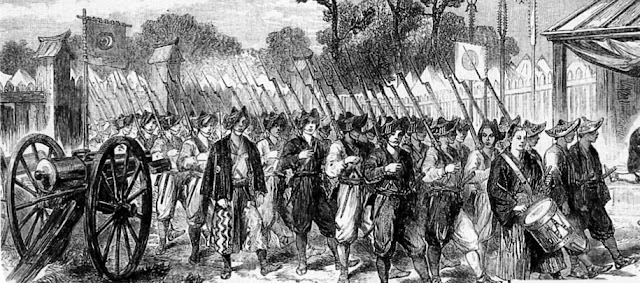The
Bakumatsu ended about a millennium history of shoguns that fascinated and led
Japan. Explore Japan’s dissent during the period of the fall of the Tokugawa
Shoguante.
Introduction
The
Bakumatsu, or the closing curtain in the Japanese, was a period in Japanese
history when the Tokugawa Shogunate or Bakufu struggled to survive in the midst
of changing political situation both home and abroad. It began during the
arrival of Matthew Perry’s “black ships” until the surrender of the Ezo
Republic when the last vestige of Tokugawa supporters fell. Clashes
and alliances between different factions within Japanese politics, further
complicated by questions on the destiny and the future of Japan as foreign
countries striving for trade rights, plagued the period. At its end, a civil war resulted to
a new chapter in Japanese history – the Meiji Era.
The
Bakumatsu covered the time from the arrival of Commodore Matthew C. Perry to
the end of the Boshin War in 1859. It saw conflicts between imperialist supporters of isolation and Shogunate supporters of opening the country.
From which a chapter unfolded with the attempt to unite the Imperial Court and
the Shogunate and to expel the barbarians from the Land of the Rising Sun. Then
came the opposition to the union by Choshu samurais resulting to military clashes. And lastly, developments in foreign relations and
local politics led to altercations leading to the Boshin War, where the Tokugawa
House fought for power and their wealth.
Bakumatsu: Story of a Decline and Fall
 |
| Edward Gibbon |
Decline
and collapse defined the Bakumatsu period. Edward Gibbon’s enumeration of the
causes of the fall of Rome somehow paralleled the decline and fall of the Tokugawa
Shogunate. Gibbon listed:
“I. The Injuries of time and nature; II. The Hostile attacks of the Barbarians and Christians; III. The use and abuse of the materials; And, IV. The Domestic Quarrels of the Romans.”
From
the essence of the list and in Japanese context, all of
which presented itself the Bakumatsu. Firstly, the long peace that Japan experience
under the Tokugawa dulled the martial spirits of its samurais and its isolation
left its leaders weak and oblivious to the changing world. Secondly, the
Bakumatsu saw the coming and interfering of what the Japanese called as foreign
“barbarians” – westerners – to its daily life, resulting to divide. Thirdly, in
part of the house of Tokugawa, allegations of corruption and luxurious and extravagant
lifestyle ruined the credibility of the Shogunate. Also, the sudden opening of
Japan resulted to financial disruption that worsened the situation. Lastly, as
a result of commercial treaties with the foreign barbarian’s various
influential and significant personage in Japanese politics quarreled over
policies Japan must undertake.
For
Japan, the Bakumatsu served as a junction when two ancient institution
struggled for the leadership for the path to which country would partake.
Samurais, Daimyos, and Lords search for their stand in an unprecedented and
sudden arrival of foreigners. Some believed in opening the country for the sake
of peace while other argued for isolation for the sake of safety and independence.
The conflict caused much of the complexity of the Bakumastu.
It also tested old Japanese institutions - the Shogun and the samurais. Their usage in a modern and changing world placed them in the limelight of the era. Complexities which would be discussed in the following posts.
Go to: The Bakumatsu (Part 1): Opening of Japan
It also tested old Japanese institutions - the Shogun and the samurais. Their usage in a modern and changing world placed them in the limelight of the era. Complexities which would be discussed in the following posts.
Go to: The Bakumatsu (Part 1): Opening of Japan

No comments:
Post a Comment